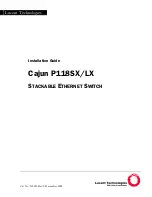
59
Chapter 5: Configuring Device Security
Defining Access Control
SFE1000P Gigabit Ethernet Switch Reference Guide
Chapter
5
–
IGP
—
Interior Gateway Protocol
(IGP). Allows for routing information exchange
between gateways in an autonomous network.
–
UDP
—
User Datagram Protocol
(UDP). Communication protocol that transmits packets
but does not guarantee their delivery.
–
HMP
—
Host Mapping Protocol
(HMP). Collects network information from various
networks hosts. HMP monitors hosts spread over the internet as well as hosts in a single
network.
–
RDP
—
Remote Desktop Protocol
(RDP). Allows a clients to communicate with the
Terminal Server over the network.
–
IDPR
— Matches the packet to the
Inter-Domain Policy Routing
(IDPR) protocol.
–
IPV6
— I
nternet Routing Protocol version 6
(IPv6). Provides a newer version of the
Internet Protocol, and follows IP version 4 (IPv4). IPv6 increases the IP address size from
32 bits to 128 bits. In addition, IPv6 support more levels of addressing hierarchy, more
addressable nodes, and supports simpler auto-configuration of addresses.
–
IPV6:ROUTE
— Matches packets to the IPv6 Route through a Gateway (IPV6:ROUTE).
–
I
PV6:FRAG
— Matches packets to the
IPv6 Fragment Header
(IPV6:FRAG).
–
IDRP
— Matches the packet to the
Inter-Domain Routing Protocol
(IDRP).
–
RSVP
— Matches the packet to the
ReSerVation Protocol
(RSVP).
–
AH
—
Authentication Header
(AH). Provides source host authentication and data
integrity.
–
IPV6:ICMP
— Matches packets to the Matches packets to the IPv6 and I
nternet Control
Message Protocol
.
–
EIGRP
—
Enhanced Interior Gateway Routing Protocol
(EIGRP). Provides fast
convergence, support for variable-length subnet mask, and supports multiple network
layer protocols.
–
OSPF
— The
Open Shortest Path First
(OSPF) protocol is a link-state, hierarchical
interior gateway protocol (IGP) for network routing Layer Two (2) Tunneling Protocol, an
extension to the PPP protocol that enables ISPs to operate Virtual Private Networks
(VPNs).
–
IPIP
—
IP over IP
(IPIP). Encapsulates IP packets to create tunnels between two routers.
This ensure that IPIP tunnel appears as a single interface, rather than several separate
interfaces. IPIP enables tunnel intranets over the internet, and provides an alternative to
source routing.
–
PIM
— Matches the packet to
Protocol Independent Multicast
(PIM).
–
L2TP
— Matches the packet to
Layer 2 Internet Protocol
(L2IP).
















































